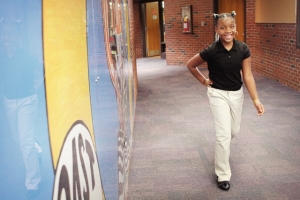It's all in a uniform
By Phyllis Moore
Published in News on September 9, 2012 1:50 AM

News-Argus/MICHAEL BETTS
Justin Taylor, a third-grader at North Drive Elementary School, wears a solid color collared shirt, in line with the higher standard dress code in place at four Wayne County public schools.

News-Argus/MICHAEL BETTS
Shi'Anah Williams, a fourth-grader at North Drive Elementary School, wears an outfit that falls under recommendations of the higher standard dress code -- a solid color shirt and pants. �
Shi'Anah Williams has a system for what she will wear to school -- from what she buys to how she picks out each day's outfit.
"We look for a lot of white shirts, black shirts. I like looking sometimes for red and pink shirts," she said of this year's back-to-school shopping trip.
She enjoyed shopping with her family, the 9-year-old fourth-grader at North Drive Elementary School said.
And she even likes doing whatever it takes to make sure everything looks crisp and polished.
"I get all my clothes out, and then we iron them the same day so we don't have to iron for the whole week," she said.
Choosing what to wear can be done "all different ways," she said, while classmate Tatyana Weathersbe, also 9, and Justin Taylor, an 8-year-old third-grader, said they prefer to select their outfits the night before to simplify getting ready for the school the next morning.
There are some rules however. All three students attend a school that has implemented the district's higher standard dress code, approved by the Board of Education in June 2007.
A districtwide dress code is in place at all schools. But in March 2007, the school board approved changes for a more uniform look, allowing parents to weigh in.
To be implemented, a survey was sent home detailing the proposed plan. It required 70 percent of parents responding in the affirmative for it to pass.
The proposed higher standard dress code was simple. It featured specific colors of solid color shirts, pants and shorts or skorts free of labels and graphics and no blue jeans.
Six schools approved it -- Brogden and Dillard middle schools, Goldsboro Intermediate, and Carver Heights, North Drive and School Street elementary schools.
At the end of the first school year, in June 2008, principals from those schools appeared before the school board, giving "glowing reports" of the dress code, crediting it with bolstering attendance, reducing discipline problems and even improving self-esteem among students and staff.
It seemed to be running along without a hitch, until the fall of 2011, when school board member Len Henderson raised concerns.
He suggested that because each year there is a new student and parent population, the schools enforcing the higher standard dress code should be given the option to again take a vote. Others on the board felt it could be problematic to change the dress code from year to year.
Officials said the policy does allow for changes, and schools are free to poll the parents and revisit the issue as needed.
The first step in the process lies with the Parent Advisory Council, said Olivia Pierce, executive director for information/technology services for the district. If the majority of the council proposes the change, a survey is then sent to all parents, she explained.
"Seventy percent of the returned surveys must be in favor (to maintain or rescind the dress code)," she said.
Currently, four schools are still adhering to the higher standard dress code, Mrs. Pierce said. Goldsboro Intermediate merged with Dillard Middle, which decided not to continue this year.
"As far as I know, it's going fine," Mrs. Pierce said. "I still hear positive comments even from parents, who like having that standard dress code. Certainly, we hear positive comments from administration and faculty at those schools."
William Vann, in his second year as principal at Carver Heights, said it has "worked exceptionally well" there.
"Our parents are in support of it," he said. "As a matter of fact, our Parent Advisory Council is in complete support of it. They have not voted to send it out to the parents to have it removed."
The only issue he has observed, he said, is parents sometimes being unable to find the recommended colors.
"What we have done is open up the colors, so that they can have the flexibility," he said. "For instance, our colors used to be white, green, black and blue. Now I have told the parents if they have a hard time finding the colors, as long as it's a polo-type shirt and still follows the guidelines -- no logos, etc."
It's important, Vann said, to accommodate and support parents working to have their child in compliance with the rules.
"(The dress code) is easier for the parents," he said. "They don't have to worry about going out and buying the latest name brand or designer. They like the idea of everybody being able to come to school and everybody looks the same and not be bullied."
"If everyone has on a uniform, nobody can have a reason to pick on you," Shi'Anah said.
Carol Artis, principal at North Drive, said the dress code has been a "good thing" in many ways.
"It has helped a lot with self-esteem and behavior because it also brings a sense of community and it establishes a framework in every area of the school," she said. "It also helps us with children that come from more impoverished backgrounds. In getting the uniforms, we are able to get two or three ideas that can be mixed and matched."
It was actually "much more difficult" to accomplish that before, she pointed out. Now, parents will donate gently used clothing their child has outgrown, which she keeps on hand for those in need or who show up at school not wearing regulation clothing. Monetary donations also go further, she said.
"If I get a donation of $50, we might not be able to buy much in the way of regular clothes," she explained. "But with the dress code, I can go get them outfitted for a whole nine weeks -- three pairs of pants, one of each color, some of the dress shirts, and we have a local business that helps us work pricing."
One of the challenges, she said, is not with the dress code as much as availability of clothing options.
"We're a small town so when one store runs out, you have to wait for them to get it back (in stock," she said. "Maxway downtown has been very cooperative and the pricing is excellent. Walmart also tends to have a lot but again, you have an influx (of shoppers) and you have to wait for that one store (if they run out)."
And while the dress code is specific, it also allows for individuality, Mrs. Artis said.
"Girls can also wear jumpers and skorts," she said. "A lot of my girlie girls, like Tatyana and Shi'Anah, they'll dress it up with the earrings and really cute tennis shoes or bracelets. They make it their own."
"Sometimes I put on my vest with my shirt," Shi'Anah said.
"What's our motto about the dress code?" Mrs. Artis asked.
"Neat and proud," the students said in unison.
They might sometimes miss getting to wear jeans, the principal said, and certainly it's not a perfect system.
"We don't always have 100 percent compliance, we just don't," she said. "But it's an elementary school. It can't be a dealbreaker during the school year at this age because children wear what their parents have put out for them, whereas at middle school they're making a conscious choice to violate the dress code.
"Typically, I call the parents and they'll be very apologetic -- things hadn't been washed, the child stayed over at a grandparents, or they're waiting for the first of the month to buy things. It's rare that they'll say they're not going to do it."
